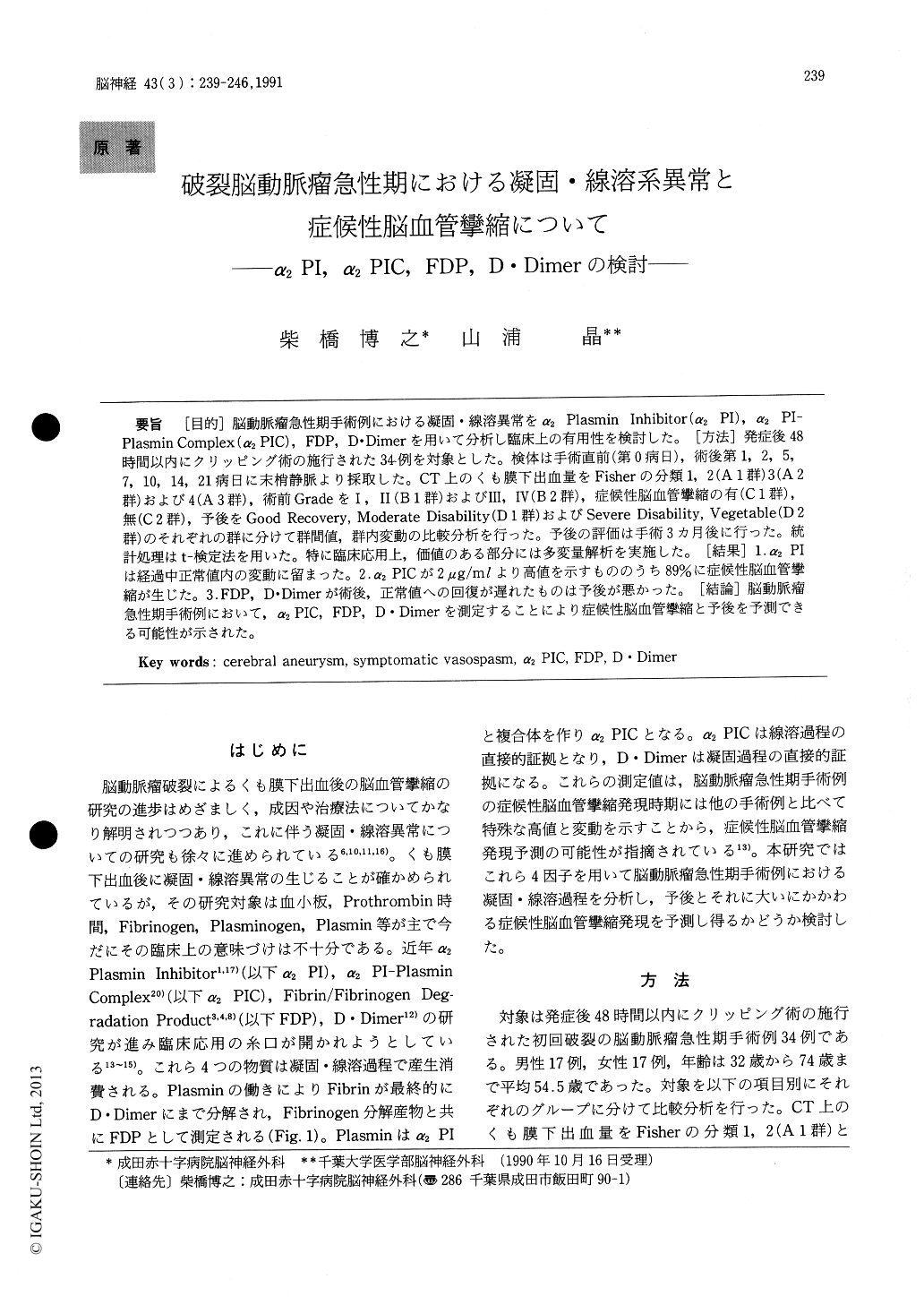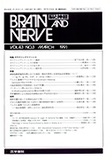Japanese
English
- 有料閲覧
- Abstract 文献概要
- 1ページ目 Look Inside
[目的]脳動脈瘤急性期手術例における凝固・線溶異常をα2Plasmin Inhibitor(α2 PI),α2 PI—Plasmin Complex(α2 PIC),FDP,D・Dimerを用いて分析し臨床上の有用性を検討した。[方法]発症後48時間以内にクリッピング術の施行された34例を対象とした。検体は手術直前(第0病日),術後第1,2,5,7,10,14,21病日に末梢静脈より採取した。CT上のくも膜下出血量をFisherの分類1,2(A 1群)3(A 2群)および4(A 3群),術前GradeをI,II(B1群)およびIII,IV(B 2群),症候性脳血管攣縮の有(C 1群),無(C2群),予後をGood Recovery,Moderate Disability(D 1群)およびSevere Disability,Vegetable(D 2群)のそれぞれの群に分けて群間値,群内変動の比較分析を行った。予後の評価は手術3カ月後に行った。統計処理はt—検定法を用いた。特に臨床応用上,価値のある部分には多変量解析を実施した。[結果]1.α2 PIは経過中正常値内の変動に留まった。2.α2 PICが2μg/mlより高値を示すもののうち89%に症候性脳血管攣縮が生じた。3.FDP,D・Dimerが術後,正常値への回復が遅れたものは予後が悪かった。[結論]脳動脈瘤急性期手術例において,α2 PIC,FDP,D・Dimerを測定することにより症侯性脳血管攣縮と予後を予測できる可能性が示された。
In this study, α2 plasmin inhibitor ( α2 PI) , α2 PI-plasmin complex (α2 PIC) , FDP (Fibrinogen/ Fibrin Degradation Product) and D ? Dimer were analyzed to confirm their clinical usefulness for estimation of symptomatic vasospasm and outcome. That included 34 patients operated on by clipping of aneurysm within 48 hours after onset. The patients were divided into two or three groups for each of the following items : Subarachnoid hemorrhage ; Group Al (Fisher's classification 1 and 2) and Group A2 (3) and Group A3 (4) , Preoperative grade ; Group B1 (Hunt and Kosnik I and II) and GroupB2 (III and IV), Symptomatic vasospasm ; Group C1 (present) and Group C2 (absent), Outcome ; Group D1 (good recovery, moderate disability) and Group D2 (severe disability, vegetable). Peripheral venous blood was collected on the day before operation (Day 0) and first, second, 5th, 7th, 10th, 14th, 21st day after operation. Results are following. α2 PI was found to change without significant intergroup or intragroup difference. α2 PIC was significantly higher in A2 group than Al group at 0 and 2nd day (p<0.05) , in B2 group than B1 group at 0 day (p< 0.05) and in Cl group than C2 group at 0 day and 5th day (p<0.05). Namely, α2 PIC was already high before operation in patients with severe subarach-noid hemorrhage, poorer grade and/or symptomatic vasospasm. FDP was significantly higher in A2 group than Al group at 0, 5th and 7th day (p<0.01 or p<0.05) , in B2 group than B1 group at 0 and 7th day (p<0.05) and in Cl group than C2 group at 5th and 7th day (p<0.05) . FDP decreased sharply in the period from 5th to 21st day in D1 group, whereas it was high and remained significantly higher in D2 group at 21st day. Namely, FDP was already high before operation in patients with severe subarach-noid hemorrhage and/or poorer grade, and it fur-ther increased after operation. Specially, it was high after operation in patients with symptomatic vasospasm. In patients with poor outcome, return to the normal value was delayed. D・Dimer was significantly higher in A2 group than Al group at 0 day (p<0.05) , in B2 group than B1 group than B1 group at 0 day (p<0.05) and in C1 group than C2 group at 0 day (p<0.05) . D・Dimer sharply de-creased in Dl group from 5th day, while it was still significantly higher in D2 group even at 14th day (p<0.05) . Namely, in patients with severe subarach-noid hemorrhage, poorer grade and/or symptomatic vasospasm, D・Dimer was high before operation. In patients with poor outcome, return to the normal value was delayed after operation. Then, α2 PIC was high before operation in patients with severe subarachnoid hemorrhage and/or poorer grade, as well as in patients with symptomatic vasospasm. This fact supports the conventional theory that symptomatic vasospasm is apt to occur in patients with severe subarachnoid hemorrhage and/or poor-er grade before operation. Briefly, those results suggest that preoperative determination of α2 PIC may make it possible to predict the occurrence of symptomatic vasospasm. However, FDP increased only 5th and 7th day when symptomatic vasospasm had often already occurred and this parameter was found to be unsuitable to predict symptomatic vasospasm in terms of timing. It seemed to be a useful clue to know the outcome whether, or not, FDP and D・Dimer would return rapidly to normalafter operation. In the case where D・Dimer was high before operation, it could be expected to pre-dict symptomatic vasospasm as well as α2 PIC, and similarly to FDP, the way in which it returns to the normal value, -or whether it returns rapidly-, will be a clue to know the outcome. The reliability of prediction of symptomatic vasospasm was found tobe as high as about 90% in patients with α2 PIC levels of 2.0 μg/ml above. However, for D・Dimer, the reliability was no more than 67% and this parameter was unsuitable to predict the occurrence of symptomatic vasospasm.

Copyright © 1991, Igaku-Shoin Ltd. All rights reserved.


